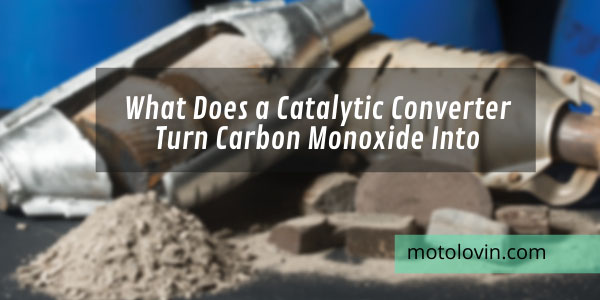Rev up your curiosity, fellow car enthusiasts! Today, we’re delving deep into the heart of your vehicle’s exhaust system to uncover the hidden marvel that is the catalytic converter.
Have you ever wondered what this unassuming component does with the harmful carbon monoxide that comes gushing out of your engine?
Buckle up, as we embark on a journey through chemistry, combustion, and the remarkable role of catalytic converters in keeping our air clean.
What Does a Catalytic Converter Turn Carbon Monoxide Into
The secret behind what a catalytic converter turns carbon monoxide into lies in the realm of chemical reactions and molecular transformations.
To answer the burning question – a catalytic converter turns carbon monoxide (CO) into carbon dioxide (CO2) through a process known as oxidation. Yes, you read that right; this unassuming device is like a mini-chemist under your car, orchestrating a critical dance of elements.
1. Catalysts at Play: At the core of the catalytic converter’s magic are precious metals like platinum, palladium, and rhodium.
These catalysts act as matchmakers, facilitating a chemical reaction between carbon monoxide and oxygen.
As your vehicle’s exhaust gases flow through the converter, these metals coax the carbon monoxide and oxygen molecules to engage in a chemical tango, transforming them into carbon dioxide.
2. Oxygen’s Vital Role: Oxygen is the unsung hero in this transformational dance. It acts as the essential partner that carbon monoxide needs to step into its new role as carbon dioxide.
The catalytic converter creates an environment where oxygen molecules can readily interact with carbon monoxide, leading to the conversion that significantly reduces the harmful impact of carbon monoxide emissions.
3. Oxidation: A Chemical Symphony: The process itself is called oxidation – a fundamental chemical reaction where a substance combines with oxygen.
Through oxidation, carbon monoxide’s potentially lethal nature is defused, and it is transformed into carbon dioxide, which is far less harmful to the environment and our health.
Statistical Glimpse: The Impact of Catalytic Converters
A quick glimpse at the impact catalytic converters have made over the years reveals their crucial role in curbing harmful emissions.
According to environmental studies, catalytic converters have been instrumental in reducing carbon monoxide emissions from vehicles by approximately 85% since their widespread adoption.
This staggering statistic underscores the significant contribution these unassuming devices have made to air quality and public health.
Unveiling the Chemical Symphony Within Your Catalytic Converter
Beneath the hood of your vehicle, a chemical symphony plays out within the confines of your catalytic converter.
While the transformation of carbon monoxide into carbon dioxide takes center stage, several other intricate reactions contribute to the concert of emissions reduction.
.
1. Taming Nitrogen Oxides: Nitrogen oxides (NOx) are notorious pollutants that contribute to smog and respiratory issues. Within the catalytic converter, a duo of reactions – reduction and oxidation – tackle these harmful compounds.
During reduction, precious metals act as catalysts, helping to convert nitrogen oxides into nitrogen gas and oxygen.
Subsequently, oxidation reactions further transform unreacted NOx into less harmful nitrogen dioxide (NO2), which can be converted into nitrogen and oxygen through subsequent interactions.
2. Hydrocarbon Harmony: Hydrocarbons, unburned fuel remnants, enter the catalytic converter’s arena, where oxidation reactions dance with them.
The catalyst promotes the conversion of hydrocarbons into water vapor (H2O) and carbon dioxide (CO2), significantly reducing their impact on the environment.
This harmonious process turns what could be pollutants into innocuous elements.
3. The Oxygen Tango: Oxygen plays a multifaceted role within the catalytic converter.
Not only is it an essential partner in oxidation reactions, but it also plays a role in enhancing the efficiency of the precious metal catalysts.
The careful balance of oxygen within the converter’s environment ensures optimal performance and drives the conversion of harmful gases into benign substances.
4. Carbon Monoxide Alchemy: While we’ve already highlighted the conversion of carbon monoxide (CO) into carbon dioxide (CO2), this reaction is worth a second look.
The catalysts within the converter facilitate an intricate dance between carbon monoxide and oxygen, promoting a swift transformation that significantly reduces the harmful impact of this lethal gas.
5. Efficiency Maximization: Modern catalytic converters are engineered for efficiency, which is achieved through a delicate interplay of chemical reactions.
By optimizing the conversion of pollutants into less harmful substances, catalytic converters contribute to cleaner emissions and a healthier environment.
6. Innovations on the Horizon: The world of catalytic converters is not stagnant; it’s a realm of constant innovation.
Researchers are exploring novel catalyst materials, coatings, and designs that can enhance performance, reduce reliance on precious metals, and further elevate the efficiency of these emissions-reducing marvels.
Also read: What does a catalytic converter turn Nitrogen Oxide into
As you navigate the roads, envision your catalytic converter as a chemist of sorts, orchestrating an intricate dance of elements and compounds.
With each turn of the engine, remember that this chemical symphony within your vehicle’s exhaust system is a testament to human ingenuity and our commitment to a cleaner, greener future.
The next time you admire the seemingly mundane components under your hood, take a moment to appreciate the remarkable reactions that transform emissions into an eco-friendly melody.
